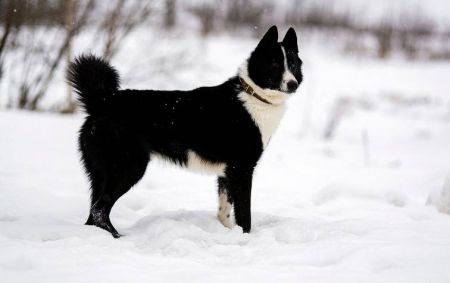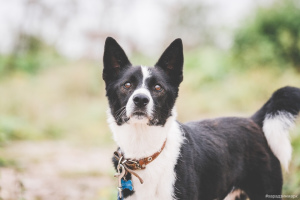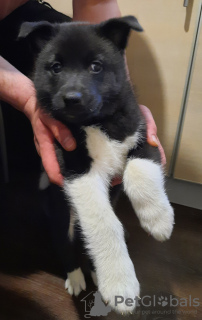Russo-European Laika
Fit for allergics: No
Name of the breed: Russo-European Laika
For families with children: Yes
Dog guard: No
Difficulty of care: No
Guide-dog: Yes
Ability to train: Yes
 Interesting Facts
Interesting Facts
- These quadrupeds belong to the “Spitz” group.
- The following fact about the Russian-European husky causes incredible amazement: these seemingly small dogs are capable of hunting even a bear and a wolf!

- These dogs are often attracted to the work of apprehending criminals.
- Many owners were faced with the fact of the Russian-European husky, that they could pursue their sacrifice even the essence without stopping!
- The average duration of their life is 12-14 years.
_120x126.jpg) Breed origin
Breed origin
The story of this dog is short, and it began in the Soviet Union. It was decided that a good hunting dog should be bred. The institute of hunting, which is located in the Kaliningrad region, took on this business. There, as a result of mating different types of huskies, this breed was bred. Then, the history of the origin of the Russian-European husky continued after its recognition in 1980 by the International Canine Federation.
_120x127.jpg) Description of Russian-European likes
Description of Russian-European likes
These four-legged have medium-sized parameters, differ in well-built muscles and strength. Description of the Russian-European husky should start with its parameters: growth within 48-58 cm, and weight - 18-23 kg. The tail is long, twisted, and the limbs are straight and parallel to each other.
A Russian-European husky breed dog is characterized by a triangular head, on which you can see a not very obvious transition from the forehead to the muzzle, which by the way is quite wide at the base, but closer to the nose it narrows noticeably. Her eyes are oval and brown in color. Triangular ears are high, erect.
Breed Russian-European Laika endowed with a coat with a hard guard hair and softer undercoat. There is only one color possible - these are various combinations of black and white colors.
_120x129.jpg) Dog content
Dog content
These dogs feel best in a big house with a huge house territory. There, they can run, jump and realize their physical potential. Of course, they can live in the apartment, but then the owners will need to take care of her frequent and long-term walking.
Wool does not require close attention to itself in the matter of the content of the Russian-European husky. It is necessary to wash it only when necessary, you can comb it no more than 1 time per week, and your teeth, ears and eyes will be sufficient to inspect from time to time.
_120x106.png) How to feed the Russian-European husky?
How to feed the Russian-European husky?
These dogs have excellent health, but of course, for the prevention of various diseases it is recommended to adhere to proper nutrition. The best answer to the question of how to feed a Russian-European husky will be raw meat and fish. Yes Yes! That's right. This is due to the fact that Russian-European Laika is a hunter by nature and that is why raw food is natural for her. Such food is about ¾ of the diet.
If you decide to start a Russian-European husky, it is better to take care of vitamins for it. It is preferable to give them in the cold seasons of the year.
Accounting for the amount of food consumed should be calculated on the basis of the amount of energy expended by it per day. Also they should not be given food from the table, smoked meats and spices.
_120x120.png) Russian-European husky training
Russian-European husky training
You need to start training a Russian-European husky dog from the very first months after its birth. At first it is her socialization, i.e. training for home, toilet, walks, behavior on the street, at a party, in the presence of strangers and animals. This is very important in view of the fact that some bitterness is genetically incorporated in these dogs.
Then the training of Russian-European likes continues with the study of basic skills and teams. They can be very stubborn, so it is necessary to show perseverance, perseverance and confidence. Shouting and beating her is not worth it, you should still use the method of "gingerbread" and not "stick".
Training in hunting business is carried out by real professionals of this craft.
Do you like this breed? Choose a suitable offer on PetGlobals.com!
We collected the advertisements from all around the world and placed them on international platform for buying/selling pets. Only on our Web-site you can find the most rare breeds of cats and dogs!
Advertisements for buying/selling cats
Advertisements for buying/selling dogs
With help of PetGlobals.com your future pet is closer to you!
 Select language
Select language 











.png)
